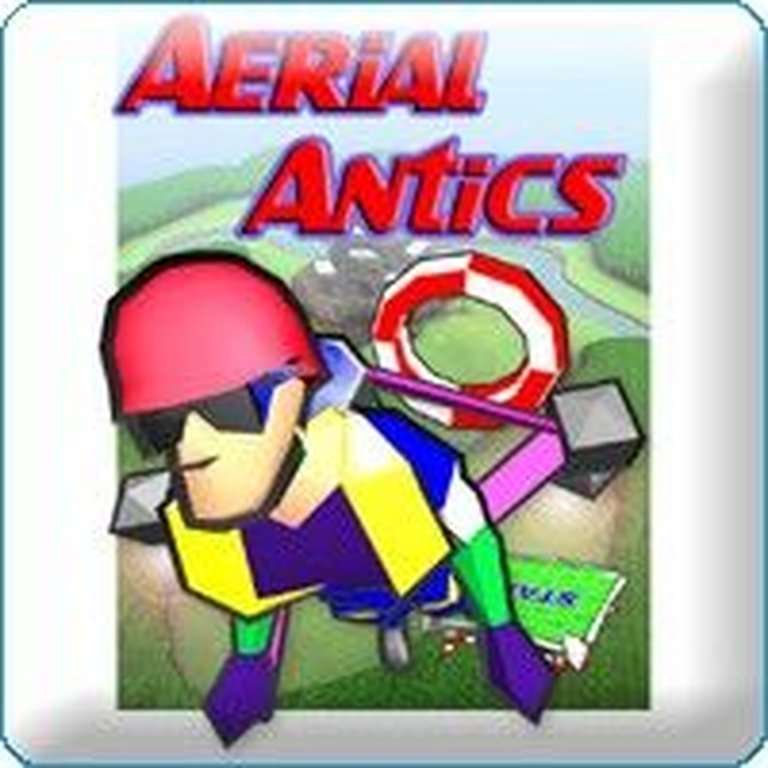- Release Year: 2004
- Platforms: Windows
- Publisher: Leadfoot Productions
- Developer: Leadfoot Productions
- Genre: Action, Aviation, Flight, Vehicular
- Perspective: Behind view
- Game Mode: LAN, Online Co-op, Single-player
- Gameplay: Arcade, Flight, Puzzle
- Average Score: 74/100

Description
Aerial Antics is an arcade-style flying game where players control a jetpack-wearing character through various courses. The gameplay is reminiscent of the rocket belt segments in Pilotwings, requiring players to navigate through floating hoops and reach landing pads while managing direction and stabilization with keyboard and mouse controls.
Where to Buy Aerial Antics
PC
Aerial Antics Free Download
Guides & Walkthroughs
Reviews & Reception
mobygames.com (74/100): Critics gave it an average score of 74%.
Aerial Antics: A Retrospective Review
Introduction
Aerial Antics (2004) is a hidden gem in the annals of indie flight simulation games, often overshadowed by its more famous contemporaries like Pilotwings. Developed by Leadfoot Productions, this arcade-style jetpack game offers a unique blend of physics-based flight mechanics and circus-themed challenges. Despite its modest critical reception at launch, Aerial Antics has since garnered a cult following, particularly after its 20th-anniversary re-release. This review will dissect the game’s development, narrative, gameplay, and legacy, arguing that Aerial Antics is a pioneering title that deserves recognition for its innovative mechanics and charming aesthetic.
Development History & Context
Studio & Creators
Aerial Antics was developed by Leadfoot Productions, a small indie studio composed of just five individuals. The core team included Jeremy Alessi (programming, design, concept art), Adrian Tysoe (art lead, 3D modeling), and Nick Clanton (testing, additional design). The game was built using the Blitz3D engine, a tool known for its accessibility to indie developers in the early 2000s.
Technological Constraints & Gaming Landscape
Released in January 2004, Aerial Antics emerged during a transitional period for flight simulation games. While AAA titles like Microsoft Flight Simulator dominated the market, indie developers experimented with arcade-style flight mechanics. The game’s reliance on physics-based controls was innovative for its time, though it faced criticism for its jerky movement, a common issue in early 3D physics simulations.
Inspirations & Influences
The game’s mechanics were heavily inspired by the rocket belt segments of Pilotwings, but Aerial Antics distinguished itself with its circus-themed objectives and cartoonish art style. The developers aimed to create a game that was accessible yet challenging, blending puzzle-solving with precision flight.
Narrative & Thematic Deep Dive
Plot & Characters
Aerial Antics follows an unnamed protagonist who aspires to become a world-famous aerial performer in the Aerial Antics Circus. The narrative is minimal, serving as a backdrop for the game’s core mechanics. The lack of a deep story is offset by the game’s whimsical tone, with levels set in fantastical locales like floating islands and neon-lit cities.
Themes & Tone
The game embraces a lighthearted, circus-inspired aesthetic, with objectives ranging from navigating through hoops to delivering balls to targets. The absence of a traditional narrative allows players to focus on the pure joy of flight, a theme that resonates with fans of arcade-style simulations.
Gameplay Mechanics & Systems
Core Gameplay Loop
Players control a jetpack-wearing aviator using a combination of keyboard (WSDA for direction) and mouse (stabilization and jet flow). The primary objective is to reach a landing pad while completing level-specific challenges, such as passing through hoops or guiding a ball to a target.
Physics & Controls
The game’s physics engine was praised for its realism, though some critics found the controls jerky and disorienting. The mouse-based stabilization system required precision, making it a test of reflexes and spatial awareness.
Progression & Challenges
The game features 50 levels across five distinct locales, each introducing new mechanics. The difficulty curve is steep, rewarding players who master the controls. However, the lack of a tutorial or gradual difficulty ramp was a point of criticism.
Multiplayer & Replayability
Aerial Antics supported LAN and internet multiplayer, allowing players to compete in time trials or cooperative challenges. This added longevity to the game, though online play was limited by the era’s infrastructure.
World-Building, Art & Sound
Visual Style
The game’s cartoonish, comic-book-inspired art style was a standout feature, with vibrant colors and exaggerated physics adding to the charm. The environments—ranging from tropical islands to futuristic cities—were designed to be visually engaging while maintaining performance on early 2000s hardware.
Sound Design
The soundtrack and sound effects were well-received, with upbeat, circus-like music complementing the game’s tone. The jetpack’s engine noise and environmental sounds enhanced immersion, though the audio design was not as polished as later titles.
Reception & Legacy
Critical & Commercial Reception
At launch, Aerial Antics received a mixed but respectable 74% average score from critics. Reviews praised its innovative physics and visual style, but criticized its controls and lack of polish. Despite this, the game developed a cult following, particularly among flight simulation enthusiasts.
Legacy & Influence
The game’s 20th-anniversary re-release in 2024 introduced it to a new generation of players. It was nominated for Sim Game of the Year by Game Tunnel and featured on G4’s Cinematech, cementing its place in indie gaming history. While not as influential as Pilotwings, Aerial Antics remains a testament to the creativity of early indie developers.
Conclusion
Aerial Antics is a charming, if flawed, experiment in physics-based flight simulation. Its cartoonish art style, innovative mechanics, and circus-themed challenges set it apart from contemporaries. While its controls may feel dated today, the game’s creative spirit and cult status ensure its place in gaming history. For fans of arcade-style flight games, Aerial Antics is a must-play relic of early 2000s indie gaming.
Final Verdict: 7.5/10 – A nostalgic gem with lasting appeal for flight simulation enthusiasts.